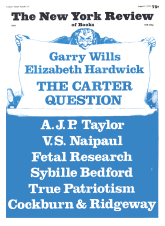In response to:
Luxe et Veritas from the April 1, 1976 issue
To the Editors:
Aside from extensive paraphrases, which he presents as his own, and phrases taken out of context, Mr. Honour [NYR, April 1] seems never to have bothered to read even the Introduction to my book, The Sculptures of Houdon. Also, he does not seem to be competent to review a book on an eighteenth-century sculptor.
As far as Neoclassicism is concerned, which he talks about exclusively, his claim to authority is that in 1968 he published a brief Pelican paperback on the subject in a series of which I gather he is also an editor. Despite some pompous listing of obvious works on Neoclassicism, the source for his presentation of the subject is Robert Rosenblum’s essays on Transformations in Late Eighteenth Century Art, Princeton, 1967. This is a valuable re-examination of some of the problems, principally iconographic, in the latter eighteenth century. Rosenblum refers to “that unwieldy corpus of art which was created from about 1760 on and which has been loosely categorized as Neoclassic.” Mr. Honour, in the first sentence of his pastiche, transforms this into “Neoclassicism is the style of the late eighteenth century….” Here is the difference between the approach of a scholar and a popularizer.
My book on Houdon’s sculptures is a monograph which examines the nature of his portraits and attempts to separate the works directly from his hand from the vast number of recasts, replicas and forgeries that exist. References to Neoclassicism are only peripheral and have to do with certain classic subjects and motifs by Houdon which I compare and contrast favorably with the Neoclassicism of Canova and his followers. Since I gather Mr. Honour proposes to do a book on Canova—if it has appeared, I have not seen it—I seem to have hurt his feelings.
Mr. Honour is obsessed with the label of Neoclassicism. He takes Professor Rosenblum’s carefully qualified observations and, basing his generalizations on them, attempts to compress everything that happened in the latter eighteenth century under the label of Neoclassicism. It is important to note that Professor Rosenblum’s remarks were based almost entirely on painting of the period, whereas I am talking about the sculpture of Jean-Antoine Houdon. When I raised the question of Houdon’s classicism with Professor Rosenblum, whose opinions I respect even when I differ with them, he admitted, modestly, that he had not studied the sculpture sufficiently to feel competent to speak about it. Mr. Honour apparently has no such reservation and I would only suggest that he spend some time looking at the sculpture of the latter eighteenth century.
If Bob Rosenblum would like to discuss with me questions of Neoclassicism in eighteenth century sculpture I would be happy to do so, and he knows how to reach me. I have no interest in discussing the matter with a vulgarisateur of the subject.
H. Harvard Arnason
Roxbury, Connecticut
This Issue
August 5, 1976



